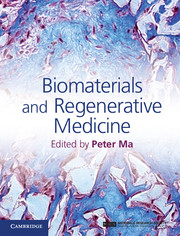Book contents
Preface
Published online by Cambridge University Press: 05 February 2015
Summary
Regenerative medicine aims to regenerate tissues and organs for medical therapies by harnessing the regenerative potentials of various stem cells. Stem cells include embryonic stem cells, multipotent adult stem cells, tissue specific stem cells, and induced pluripotent stem cells. These stem cells are the driving force for regeneration. There is a growing recognition of the effect of the three-dimensional (3D) matrix microenvironment on the fate and function of stem cells. A key challenge facing regenerative medicine is to generate 3D microenvironments (matrix, signals, supporting cells etc.) that can recapitulate those in development or healing to maintain stemness, to accelerate proliferation, or to direct the stem cells to differentiate toward a specific therapeutic lineage. Biomaterials can serve as 3D matrices; they can play critical roles in creating the 3D microenvironments for stem cells to facilitate regeneration. As the interactions and the overlap of the fields of biomaterials, stem cells, and regenerative medicine are rapidly growing, there is an urgent need for understanding of, and technologies to utilize, the interactions between biomaterials and stem cells for regenerative medicine.
This book, Biomaterials and Regenerative Medicine, overviews the state-of-the-art knowledge on stem cells, interactions of biomaterials with stem cells, biomaterials design for regenerative medicine, and the animal models and clinical applications of biomaterials for regeneration. While providing a comprehensive overview of the field, the emphasis is on the design principles, fabrication technologies, physical characterization, and biological evaluation of the biomaterials for stem cell research and regenerative medicine.
- Type
- Chapter
- Information
- Biomaterials and Regenerative Medicine , pp. xv - xviPublisher: Cambridge University PressPrint publication year: 2014

